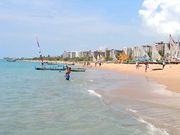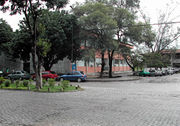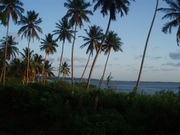Alagoas
Alagoas (AL) (Manyponds) (Portuguese pronunciation: [alaˈɡoɐs][1]) is a small state in northeastern Brazil lying between the states of Pernambuco and Sergipe; touching the state of Bahia along a part of its southwestern border. The southern border of Alagoas is defined by the Rio São Francisco (São Francisco River). From the lagoons came the name of the state, which, in the 16th century, was invaded by Portuguese and French searching for pau-Brazil (a type of wood). The Dutch first arrived in the neighboring state of Pernambuco and ended up conquering the territory.
The capital, Maceió, which borders the Rio Mundaú, is famous for its beaches and seafood and is Alagoas' most popular tourist attraction.
Contents |
Geography
The state's name originates with the lakes along its coast near the city of Maceió. The coast is bordered by fringing reefs and many fine beaches. Behind the beaches, sometimes only hundreds of meters and defined by steep scarps, lies a stretch of green coastal hills having enough rainfall for considerable agriculture and scarce remnants of the Mata Atlântica (Atlantic Rain Forest) that now is largely limited to steep hill tops or steep valley sides and bottoms. This is the area long dominated by sugar cane.
Still further inland lies the Sertão of the Northeast region of the nation. The Sertão is a high dry region dominated by scrub that is often thorn filled and sometimes toxic, the caatinga. This area and its people is famed in legend and song. It is the land of the cowboy who is clad from head to toe (if he is lucky) with very thick leather to avoid the tearing vegetation.
History
.jpg)
During the first three centuries of its history, Alagoas was part of the captaincy of Pernambuco, only changing into an independent captaincy in 1817. As a reprisal against the Pernambucan Revolution, the King John VI of Portugal ordered a vast portion of the Pernambucan territory to be taken from it, most including its southern portion, one part given to the captaincy of Bahia, the other portion made independent and creating Alagoas as a new Brazilian captaincy.
Initially, in the first years of the 16th century, Alagoas settlement went on slowly, however helped by Africans turned into slaves whose work urged the local economy. In the period of the 16th and 17th centuries, French pirates invaded its territory attracted by the commerce of Brazil wood.
Some time later, Duarte Coelho, owner of the captaincy of Pernambuco, gave the control of the region back to the Portuguese, running the territory as part of his captaincy. He increased the number of sugar cane plantations and built some sugar mills, as well as founding the cities of Penedo and Alagoas – this last one originally baptized by Portuguese as Santa Maria Madalena da Alagoa do Sul (Saint Mary Magdalene of the Southern Lake), currently the historic heritage town of Marechal Deodoro.
In 1570, a second expedition ordered by Duarte Coelho and led by Cristóvão Lins, explored the north of Alagoas and founded the settlement of Porto Calvo and five sugar mills, which two of them still endure, Buenos Aires and Escurial.
In 1630, the territory was taken by the Dutch, whose interest was to manage the commerce of sugar in most parts of the northeastern region of Brazil. As part of one of the wealthiest Brazilian captaincies, Alagoas prospered along with the sugar trade. They built Fort Maurits in Penedo, on the river São Francisco. However, the Dutch colonizers abandoned the territory after being defeated in 1646.
Decades before Alagoas was formed in 1817, its sugar industry had 200 mills, and agriculture also involved cotton, tobacco and corn plantations. With Brazilian independence from Portugal in 1822, Alagoas becomes a province. In 1839, the capital of the province was changed definitively from the town of Alagoas to Maceio, mainly due to the increasing growth of the city because of its port.
Demographics

According to the IBGE of 2008, there were 3,173,000 people residing in the state. The population density was 109.9 inh./km².
Urbanization: 67.4% (2006); Population growth: 1.3% (1991–2000); Houses: 779,000 (2006).[2]
The last PNAD (National Research for Sample of Domiciles) census revealed the following numbers: 2,100,000 Brown (Multiracial) people (66.18%), 964,000 White people (30.39%), 96,000 Black people (3.02%), 11,000 Asian people (0.35%).[3]
Statistics
- Vehicles: 287,018 (March 2007)
- Mobile phones: 1.4 million (April 2007)
- Telephones: 302,000 (April 2007)
- Cities: 102 (2007).[4]
Economy

Alagoas is one of the poorest states of Brazil[5].The service sector is the largest component of GDP at 55.8%, followed by the industrial sector at 36.9%. Agriculture represents 7.3%, of GDP (2004). Alagoas exports: sugar 58.8%, alcohol 29.4%, chemicals 9%, tobacco 2.1% (2002).
Share of the Brazilian economy: 0.7% (2004).[6]
The economy has been agricultural, dependent largely on large sugar cane plantations with some tobacco farming that is concentrated around the city of Arapiraca. Sugar cane formed the basis for an alcohol industry that is in decline. Small to medium sized tanker ships took alcohol onboard in Maceio's port with considerable frequency during the peak period. Such loads still take place with less frequency. Another local industry is based on chemical products from brine pumped from deep wells on the outskirts of Maceió.
In the last twenty years the tourist industry has found the beaches and Maceió itself has changed from a rather sleepy little port with coconut palm plantations along its beaches to high rise hotels. The northern coast, particularly around the towns Maragogi and Japaratinga is beginning to see some of this development in the form of resorts attracting people from the south and from Europe. There is considerable European investment (as of 2007) in beach property north of Maceió with walled compounds of beach homes.
Education

Portuguese is the official national language, and thus the primary language taught in schools. But English and Spanish are part of the official high school curriculum.
Educational institutions
- Universidade Federal de Alagoas (UFAL) (Federal University of Alagoas);
- Universidade Estadual de Alagoas (Uneal) (State University of Alagoas);
- Universidade de Ciências da Saúde de Alagoas (Uncisal) (University of Sciences of the Health of Alagoas);
- Centro Federal de Educação Tecnológica de Alagoas (Cefet-AL);
- Centro de Ensino Superior de Maceió (CESMAC) (Center of Higher Education of Maceió);
- Faculdade de Alagoas (FAL) (College of Alagoas);
- and many others.
Culture
Festa Junina (Saint John Festival)
Festa Junina was introduced to Northeastern Brazil by the Portuguese for whom St John's day (also celebrated as Midsummer Day in several European countries), on the 24th of June, is one of the oldest and most popular celebrations of the year. Differently, of course, from what happens on the European Midsummer Day, the festivities in Brazil do not take place during the summer solstice but during the tropical winter solstice. The festivities traditionally begin after the 12th of June, on the eve of St Anthony's day, and last until the 29th, which is Saint Peter's day. During these fifteen days, there are bonfires, fireworks, and folk dancing in the streets (step names are in French, which shows the mutual influences between court life and peasant culture in the 17th, 18th, and 19th-century Europe). Once exclusively a rural festivity, today, in Brazil, it is largely a city festival during which people joyfully and theatrically mimic peasant stereotypes and cliches in a spirit of joke and good time. Typical refreshments and dishes are served. It should be noted that, like during Carnival, these festivities involve costumes-wearing (in this case, peasant costumes), dancing and visual spectacles (fireworks display and folk dancing). Like what happens on Midsummer and St John's Day in Europe, bonfires are a central part of these festivities in Brazil.
Carnival
The four-day period before Lent leading up to Ash Wednesday is carnival time in Brazil. Rich and poor alike forget their cares as they party in the streets.
Warrior
This is a typical Alagoas revelry that resulted from the union of Reisado (an Epiphany celebration), Auto dos Caboclinhos (Caboclinhos’ Play), Chegança (public folk play depicting a naval battle) and Pastoril (outdoor folk play). Its captivating choreography and costumes with colored ribbons and beads reproduce the cathedral’s façades on the monumental hats covered with mirrors.

Fandango
This is a dramatic dance motivated by the sea. It tells the sea adventures of the first navigators in its songs accompanied by guitar and ukulele.
Carnival Bull
Boi do Carnaval is a popular culture display derived from Bumba-Meu-Boi. It is always presented together with La Ursa (The Bear), Vaqueiro (Cowboy) and a percussion band whose rhythms captivate all who hear them.
Infrastructure
International Airport
Alagoas gained a new airport complex, Zumbi dos Palmares International Airport, in Maceió Metropolitan Area, designed by homegrown architect Mário Aloísio, which combines glass, metal and granite. It includes space for art exhibitions, a panoramic deck, chapel, seven escalators, nine elevators and four boarding bridges. The whole terminal was designed to permit access by the physically disabled, with ramps and special bathroom fixtures.
In the new terminal, Infraero also brings to Maceió “Aeroshopping” – a concept that is transforming the country’s airports into centers for leisure and high-quality products and services. The entire building has a computerized air conditioning, with commercial spaces that will be occupied gradually. The parking area was more than tripled. Demand will be able to grow to 1.2 million passengers a year since the new passenger terminal has 24,000 square meters, the triple of its former size. The check-in counters were doubled and can reach higher numbers without any structural remodeling. The building is “intelligent”, meaning controlled by a computerized system that regulates factors ranging from the lighting level to air temperature and even the speed of the escalators. This system also controls access to restricted areas and the fire protection system, among others.

Highways
- BR-101
- BR-104
- BR-110
- BR-316
- BR-423
- BR-424
Port
The Port of Jaraguá is located in Maceió. The commercial and economic development of the Port of Jaraguá, on the margins of the Mundaú lagoon, was responsible for the emergence of an important settlement that received the name of Maceió and later became the present capital of Alagoas. The Port of Jaraguá is situated in a natural port area that facilitates the ships docking. During the Brazilian colonial period, the most important products exported through the port were sugar, smoke, coconut and spices.
Sports
Alagoas provides visitors and residents with various sport activities. There are several soccer clubs based in Maceió, such as ASA de Arapiraca, CRB, CSA and Corithians Alagoano.
Maceió was one of the 18 candidates to host games of the 2014 FIFA World Cup, for which Brazil is the selected host, but it did not make the final cut.
Major cities

- Arapiraca
- Coruripe
- Maceió
- Maragogi
- Marechal Deodoro (H)
- Palmeira dos Indios
- Penedo (H)
- Piranhas (H)
- Porto Calvo
- Porto de Pedras (H)
- São Miguel dos Campos
- Santana do Ipanema
- União dos Palmares
- Viçosa
Notable people
- Aurélio Buarque de Holanda Ferreira - Lexicographer, philologist, translator, and writer
- Renan Calheiros - PMDB politician and president of the Senate of Brazil
- Deodoro da Fonseca - First president of Brazil
- Djavan - Singer/songwriter
- Hermeto Pascoal - Composer and multi-instrumentalist
- Graciliano Ramos - Author
- Marta Vieira da Silva - Women's football striker
- Bruna Tenório - Fashion Model
Flag
The coat of arms symbolizes the first Alagoan settlements, Porto Calvo and Penedo. Some plantations, sugar cane and cotton, that stood out as the foremost wealth in the past are incorporated in the design. The colors in each stripe, red, white and blue, that bring to mind the French flag, symbolize exactly the motto of the French Revolution: liberty, equality and fraternity. The star above the coat represents the state itself.
References
- ↑ In Brazilian Portuguese. The European Portuguese pronunciation is [ɐlɐˈɣoɐʃ].
- ↑ Source: PNAD.
- ↑ (in Portuguese) (PDF). Alagoas, Brazil: IBGE. 2008. ISBN 85-240-3919-1. http://www.sidra.ibge.gov.br/bda/tabela/listabl.asp?z=pnad&o=3&i=P&c=262. Retrieved 2010-01-18.
- ↑ Source: IBGE.
- ↑ [1]
- ↑ (in Portuguese) (PDF) List of Brazilian states by GDP. Alagoas, Brazil: IBGE. 2004. ISBN 85-240-3919-1. http://en.wikipedia.org/wiki/List_of_Brazilian_states_by_GDP_participation. Retrieved 2007-07-18.
External links
- (Portuguese) Official Website
- (English) Brazilian Tourism Portal
- (Portuguese) Visit Alagoas
- (Portuguese) Guide of Alagoas
- (Portuguese) Ministry of Transport port data including main products exported
- (English) Brazilian Embassy in London: São Francisco River
|
||||||||||||||||||||||||||||||||||||||
|
||||||||||||||||||||||||||||||||
|
||||||||||||||||||||